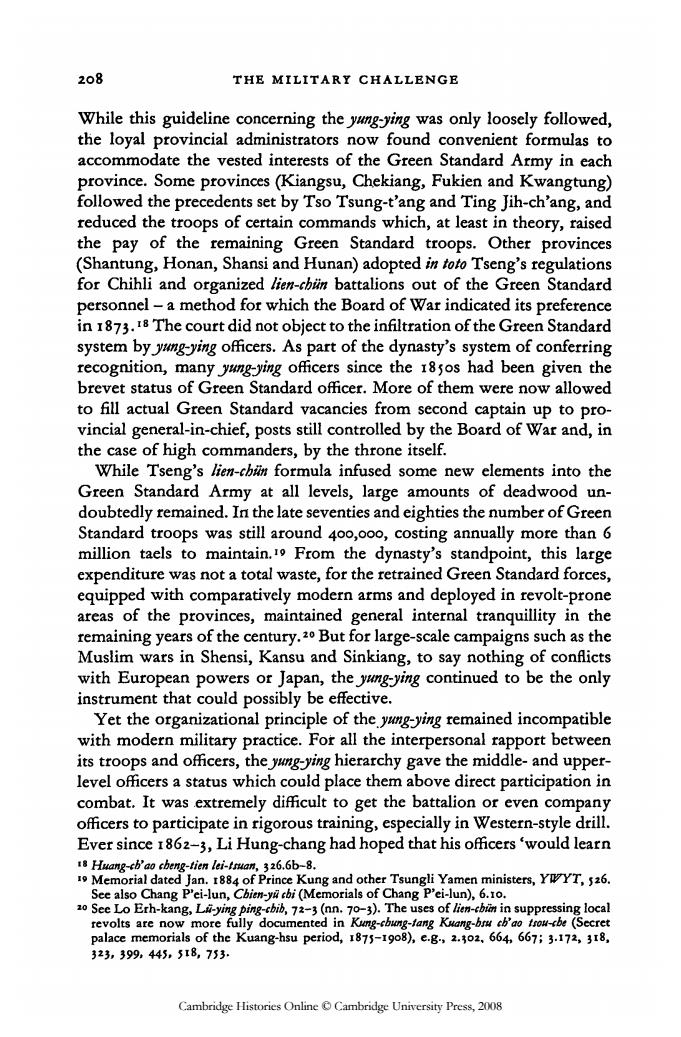正在加载图片...

2o8 THE MILITARY CHALLENGE While this guideline concerning the yung-ying was only loosely followed, the loyal provincial administrators now found convenient formulas to accommodate the vested interests of the Green Standard Army in each province.Some provinces(Kiangsu,Chekiang,Fukien and Kwangtung) followed the precedents set by Tso Tsung-t'ang and Ting Jih-ch'ang,and reduced the troops of certain commands which,at least in theory,raised the pay of the remaining Green Standard troops.Other provinces (Shantung,Honan,Shansi and Hunan)adopted in toto Tseng's regulations for Chihli and organized lien-chiin battalions out of the Green Standard personnel-a method for which the Board of War indicated its preference in 1873.18 The court did not object to the infiltration of the Green Standard system by yung-ying officers.As part of the dynasty's system of conferring recognition,many yung-ying officers since the 18sos had been given the brevet status of Green Standard officer.More of them were now allowed to fill actual Green Standard vacancies from second captain up to pro- vincial general-in-chief,posts still controlled by the Board of War and,in the case of high commanders,by the throne itself. While Tseng's lien-chiin formula infused some new elements into the Green Standard Army at all levels,large amounts of deadwood un- doubtedly remained.In the late seventies and eighties the number of Green Standard troops was still around 400,oo0,costing annually more than 6 million taels to maintain.From the dynasty's standpoint,this large expenditure was not a total waste,for the retrained Green Standard forces, equipped with comparatively modern arms and deployed in revolt-prone areas of the provinces,maintained general internal tranquillity in the remaining years of the century.But for large-scale campaigns such as the Muslim wars in Shensi,Kansu and Sinkiang,to say nothing of conflicts with European powers or Japan,the yang-ying continued to be the only instrument that could possibly be effective. Yet the organizational principle of the yung ying remained incompatible with modern military practice.For all the interpersonal rapport between its troops and officers,the yung-ying hierarchy gave the middle-and upper- level officers a status which could place them above direct participation in combat.It was extremely difficult to get the battalion or even company officers to participate in rigorous training,especially in Western-style drill. Ever since 1862-3,Li Hung-chang had hoped that his officers'would learn Huang-cb'ao cbeng-tien lei-truan,326.6b-8. Memorial dated Jan.1884 of Prince Kung and other Tsungli Yamen ministers,YWYT,526. See also Chang P'ei-lun,Chian-yi cbi(Memorials of Chang P'ei-lun),6.10. ao See Lo Erh-kang,Lfi-ying ping-cbib,72-3(nn.70-3).The uses of lien-cbiin in suppressing local revolts are now more fully documented in Kung-cbung-fang Kuang-bru ch'ao trou-cbe (Secret palace memorials of the Kuang-hsu period,1875-1908),e.g,2.02.664,667;3.172,318, 323,399,445,5I8,753 Cambridge Histories Online O Cambridge University Press,20082O8 THE MILITARY CHALLENGE While this guideline concerning the yung-ying was only loosely followed, the loyal provincial administrators now found convenient formulas to accommodate the vested interests of the Green Standard Army in each province. Some provinces (Kiangsu, Chekiang, Fukien and Kwangtung) followed the precedents set by Tso Tsung-t'ang and Ting Jih-ch'ang, and reduced the troops of certain commands which, at least in theory, raised the pay of the remaining Green Standard troops. Other provinces (Shantung, Honan, Shansi and Hunan) adopted in toto Tseng's regulations for Chihli and organized lien-chun battalions out of the Green Standard personnel - a method for which the Board of War indicated its preference in 1873.'8 The court did not object to the infiltration of the Green Standard system ty yung-ying officers. As part of the dynasty's system of conferring recognition, many yung-ying officers since the 1850s had been given the brevet status of Green Standard officer. More of them were now allowed to fill actual Green Standard vacancies from second captain up to provincial general-in-chief, posts still controlled by the Board of War and, in the case of high commanders, by the throne itself. While Tseng's lien-chun formula infused some new elements into the Green Standard Army at all levels, large amounts of deadwood undoubtedly remained. In the late seventies and eighties the number of Green Standard troops was still around 400,000, costing annually more than 6 million taels to maintain.1 ' From the dynasty's standpoint, this large expenditure was not a total waste, for the retrained Green Standard forces, equipped with comparatively modern arms and deployed in revolt-prone areas of the provinces, maintained general internal tranquillity in the remaining years of the century.20 But for large-scale campaigns such as the Muslim wars in Shensi, Kansu and Sinkiang, to say nothing of conflicts with European powers or Japan, the yung-ying continued to be the only instrument that could possibly be effective. Yet the organizational principle of the yung-ying remained incompatible with modern military practice. For all the interpersonal rapport between its troops and officers, theyung-jing hierarchy gave the middle- and upperlevel officers a status which could place them above direct participation in combat. It was extremely difficult to get the battalion or even company officers to participate in rigorous training, especially in Western-style drill. Ever since 1862-3, Li Hung-chang had hoped that his officers 'would learn 18 Huang-ch'ao cbcng-tien Ui-ttuan, 326.6D-8. '• Memorial dated Jan. 1884 of Prince Kung and other Tsungli Yamen ministers, YWYT, 526. See also Chang P'ei-lun, Cbien-yu cbi (Memorials of Chang P'ei-lun), 6.10. 20 See Lo Erh-kang, Ui-yingping-cbib, 72-3 (nn. 70-}). The uses ollien-cbun in suppressing local revolts are now more fully documented in Kung-cbung-tang Kuang-btu cb'ao tsou-cbe (Secret palace memorials of the Kuang-hsu period, 1875-1908), e.g., 2.302, 664, 667; 3.172, 318, 3*3. 399. 445. 5»8. 753- Cambridge Histories Online © Cambridge University Press, 2008